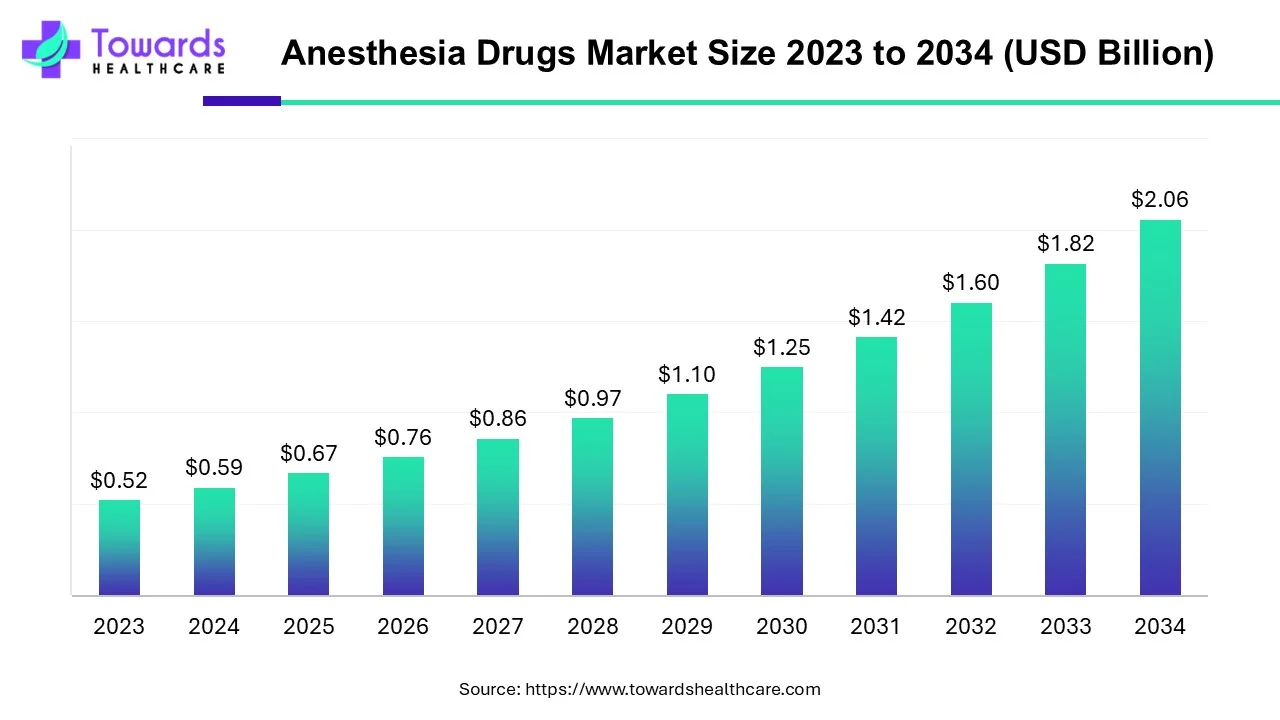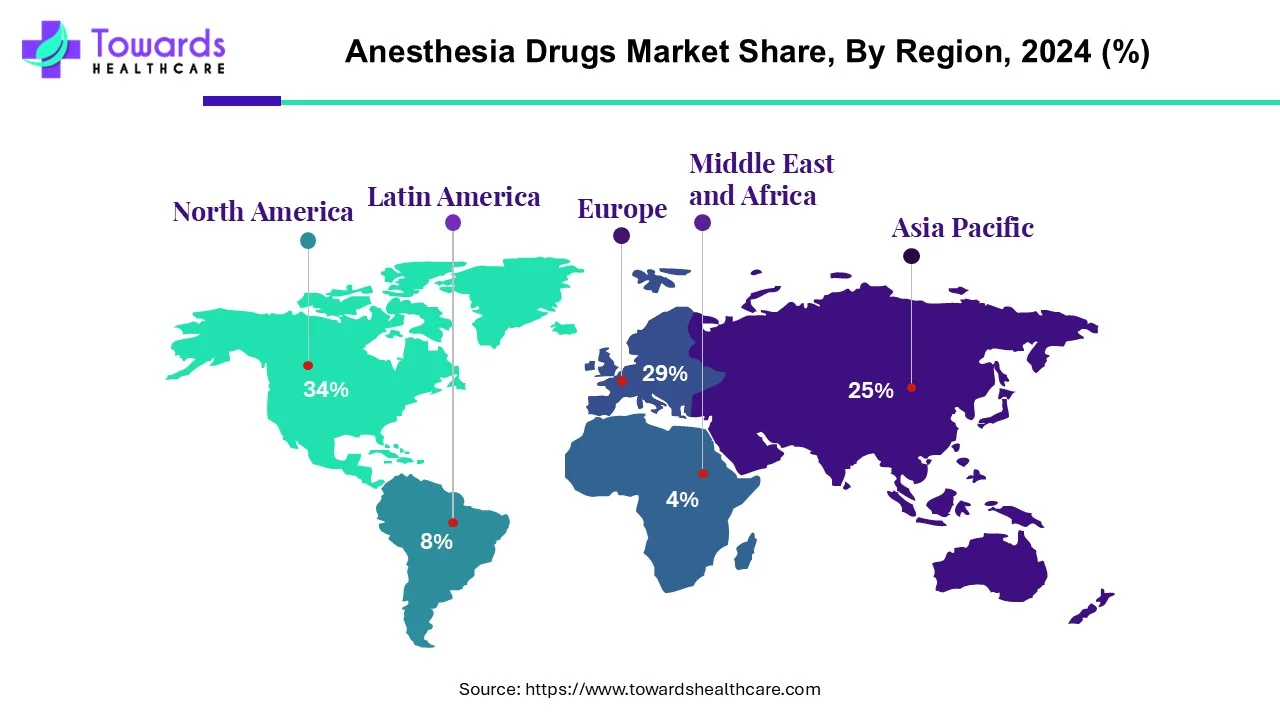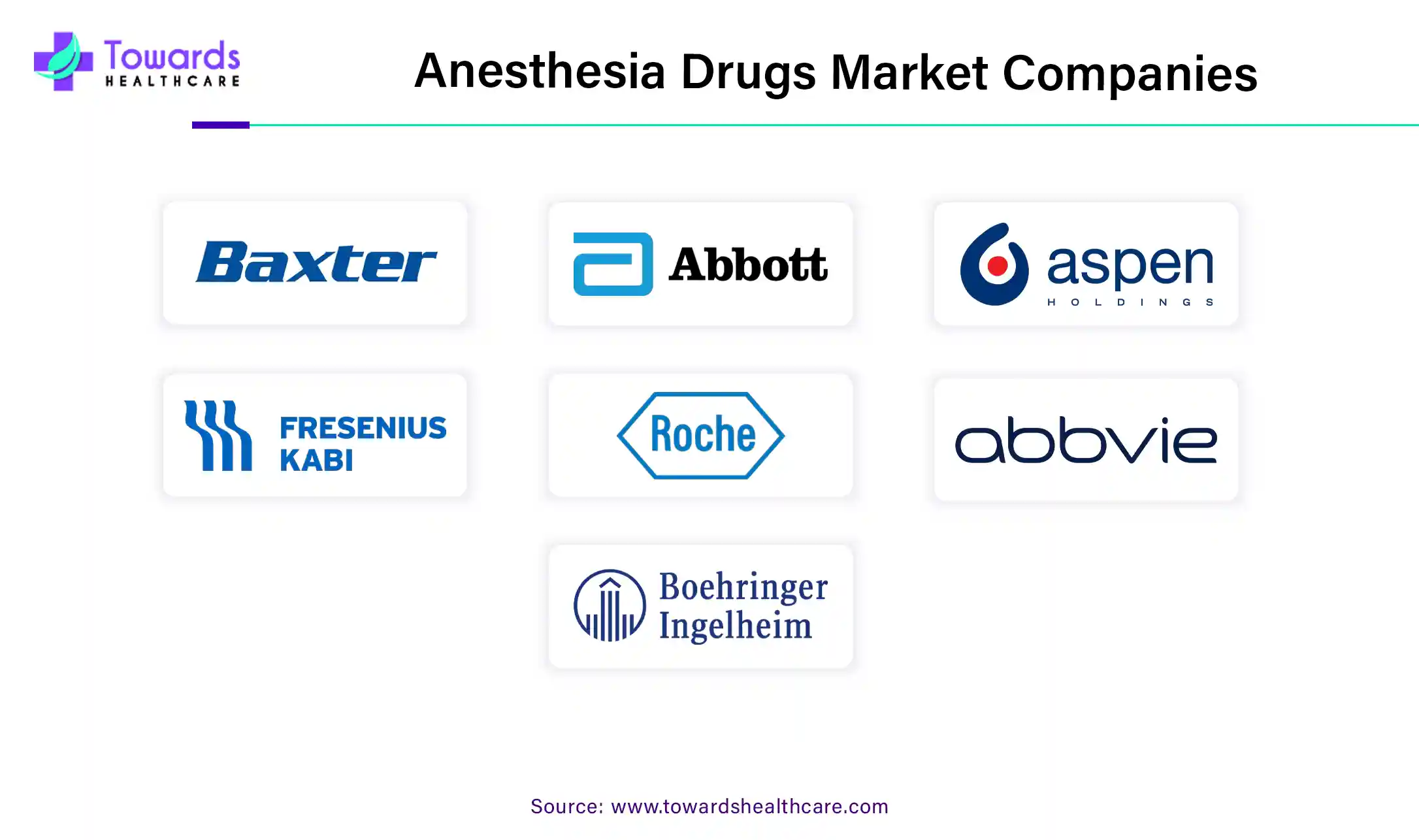December 2025

The global anesthesia drugs market size was calculated at USD 0.59 billion in 2024, to reach USD 0.669 billion in 2025 is expected to be worth USD 2.058 billion by 2034, expanding at a CAGR of 13.3% from 2024 to 2034.

Anesthesia Provides Relief To Those Who Wish To Avoid Surgical Pain
Anesthesia is a medication that makes you unconscious during surgical procedures. Anesthetics are pain-relieving medications that help patients relax during surgeries. General anesthesia drugs, regional anesthesia, epidural, spinal, and nerve block anesthesia drugs, and combined general and epidural anesthesia are all examples of anesthesia. Each type of anesthesia prevents a specific type of pain sensation.
Integrating artificial intelligence (AI) and machine learning (ML) algorithms in anesthesia practices revolutionize the field by enabling faster and more effective decision-making. AI and ML can introduce automation in anesthesia practice and predict patient outcomes, suggesting ways to overcome potential challenges. They can also determine and deliver the accurate dose to patients, depending on their type of surgery, significantly reducing manual errors. They can also suggest the type of anesthesia drugs to be administered to patients, enhancing efficiency. AI can provide real-time monitoring of patients and detect complications. Additionally, AI and ML can develop personalized anesthetic plans based on vast datasets, reducing the overload of anesthesiologists.
An Increasing Number Of Surgeries, A Geriatric Population, And Technological Advancements Are Expected To Drive Market Growth.
The increase in the number of surgeries that use anesthetics during the surgical procedure is one of the major factors driving the Anesthetics Market. An increase in surgeries is primarily due to an increase in traumatic injuries and accidents that necessitate surgical procedures. It is estimated that more than 310 million surgeries are performed every year globally.
Furthermore, technological advancements in drug delivery, the development of specifically targeted treatments, the development of equipment to monitor patients’ physiological characteristics during and after anesthetics, and reduced anesthetic side effects are driving factors that will boost market growth. According to the United Nations Department of Economic and Social Affairs, one in every four people in Europe and Northern America could be 65 or older by 2050. Chronic diseases such as cardiovascular and neurological diseases are on the rise in older populations, further increasing the demand for Anesthesia Drugs.
Lack of Infrastructure, Awareness and the High Cost of Drugs and Procedures are Limiting the Market Growth.
The lack of healthcare institutions in underdeveloped countries and remote areas, in addition to the lack of Anesthesia doctors and certified Anesthesia nurses per capita, is expected to be a restraint on the growth of the Anesthesia Drugs market. Furthermore, high prices for procedures and branded drugs will suppress market growth during the forecast period. A lack of Anesthesia awareness among the general public is another factor affecting the anesthesia drugs market.
After-surgery Impacts of Anesthesia Drugs Recovery time is critical after surgery because the patient may suffer irreversible physical damage. As a result, patients are kept under clinical observation until they regain consciousness.
Vomiting, nausea, irregular heart rhythm, body temperature, respiratory rate, sore throat, and respiratory system irritation are just a few of the major drawbacks associated with general Anesthesia Drugs that have a negative impact on the market.
Latest Innovations
The future of the anesthesia drugs market is promising, driven by the latest innovations in drug delivery systems. Several researchers are developing novel drug delivery devices to streamline the flow of anesthesia drugs within the body. Technological advancements drive the latest innovations in medical devices, enabling faster and more effective delivery. Furthermore, a growing understanding of pharmacogenomics and the urgent need to address emerging and complex health challenges also support innovative solutions for anesthesia. Apart from these, anesthesia drugs are repurposed to find their extended applications, such as epilepsy treatment. The future of the market is also driven by the growing demand for personalized medicines, providing more customized and effective care.
Furthermore, when General Anesthesia is administered during the surgical procedure, approximately one or two people out of every 1000 may be unaware that they are partially awake. There is very little chance of experiencing pain, but it is possible. Because people are given relaxation drugs prior to surgery, they are unable to move or communicate their pain or consciousness to the doctors. There is a chance that this will cause patients to experience long-term psychological problems, similar to post-traumatic stress disorder. This is known as unintentional intraoperative awareness, and it is one of the most significant challenges facing the Anesthesia market.

Since they helped doctors create personalized anesthesia plans that balance the patient's history with the anticipated surgical plan, General anesthesia drugs dominated the market due to the increasing number of major surgeries around the world. Some studies have shown that 5 million older adults will need major surgery over the next five years. The increasing C-section deliveries and road accidents lead to major surgeries. These drugs induce a sleep-like state during surgery while completely inducing sedation in patients. They are either given through intravenous or inhalation routes.
By type, the local anesthesia drugs segment is expected to grow at the fastest rate in the market during the forecast period. Local anesthesia drugs are given to numb particular organs or body parts locally while maintaining the consciousness of patients. The increasing number of minor surgeries due to sports injuries or other chronic illnesses promotes the segment’s growth. The availability of generic alternatives and increasing awareness also contribute to the segment’s growth.

Anesthetics are widely used in surgical procedures hence general surgery dominated the market. The market is expected to expand significantly over the forecasted period. The market is being driven by an increase in the number of surgeries, an aging population with an increase in the number of chronic diseases, and technological advancements in anesthesia. Some common examples of general surgeries include appendectomy, hernia repair, cataract surgery, and cesarean section.
By application, the plastic surgery segment is projected to expand rapidly in the market in the coming years. The growing demand for aesthetic appearance due to increased priority for health and wellness and recent advancements in plastic surgery technologies augment the segment’s growth. There were approximately 1.6 million plastic surgeries performed globally in 2023. The top surgeries included liposuction, breast augmentation, and abdominoplasty.

Intravenous drugs dominated the anesthesia drugs market because they provide numerous benefits such as more accurate dosing, improved patient safety, lower rates of postoperative nausea, vomiting, urinary retention, and malignant hyperthermia (a rare but serious side effect of general anesthesia), and a lower risk of blood clots and pulmonary emboli (blood clots that move to the lungs).
By route of administration, the inhalation segment is expected to grow at the fastest rate in the market during the forecast period. The recent advancements in inhalation drug delivery devices and ease of administration are likely to dominate the market. The inhalation route eliminates the side effects and pain of the injection site, enhancing patient adherence.

Each year, North America perceives a significant increase in surgical procedures. Cancer, heart disease, and cardiovascular disease are all common in this region, and they are on the rise. Due to the prevalence of these surgeries, there are numerous growth opportunities in this market. Forecasts for the US Anesthesia Drugs market show a strong increase, which will contribute to the growth of the North America anesthesia drugs market.
Because of the influence of social media influencers, there is currently a market trend for looking fit. This has resulted in an increase in the number of people wanting to change their bodies, resulting in an increase in the number of cosmetic or plastic surgeries. An increase in dental surgeries accounts for an increase in anesthesia drug demand. The risks associated with anesthesia act as a market limitation. In some cases, the use of anesthesia necessitates additional precautions. The use of general anesthesia in children and pregnant women, in particular, requires authorization.
Asia-Pacific is projected to host the fastest-growing market in the coming years. The rising number of surgeries due to an increasing number of chronic disorders drives the market. Countries like South Korea and China lead in plastic surgeries per capita globally. South Korea is referred to as the cosmetic surgery capital of the world. The increasing healthcare expenditure and favorable reimbursement policies support the market. The market is also driven by favorable government support, such as the launching of new initiatives and providing funding to support the development of anesthesia drugs. Maximum generic drugs globally are manufactured in Asia-Pacific. The suitable manufacturing infrastructure encourages foreign players to set up a manufacturing facility in the region.
The anesthesia drugs market in Europe is considered to be a significantly growing area, with countries like Germany leading in terms of market share. The growth is driven by advanced healthcare infrastructure with an aim on technological advancements and surgical procedures. Numerous pharmaceutical companies and research institutions, such as Abbott Laboratories, AbbVie Inc., AstraZeneca PLC, and others, are involved in the anesthesia drugs market in Europe. The aging population is more likely to require surgical procedures and anesthesia, along with high surgical procedure volumes, which include general surgeries, cosmetic procedures, and dental procedures, all of which require anesthesia, further driving the market expansion in Europe.

By Type
By Application
By Route of Administration
By Region
December 2025
November 2025
November 2025
November 2025